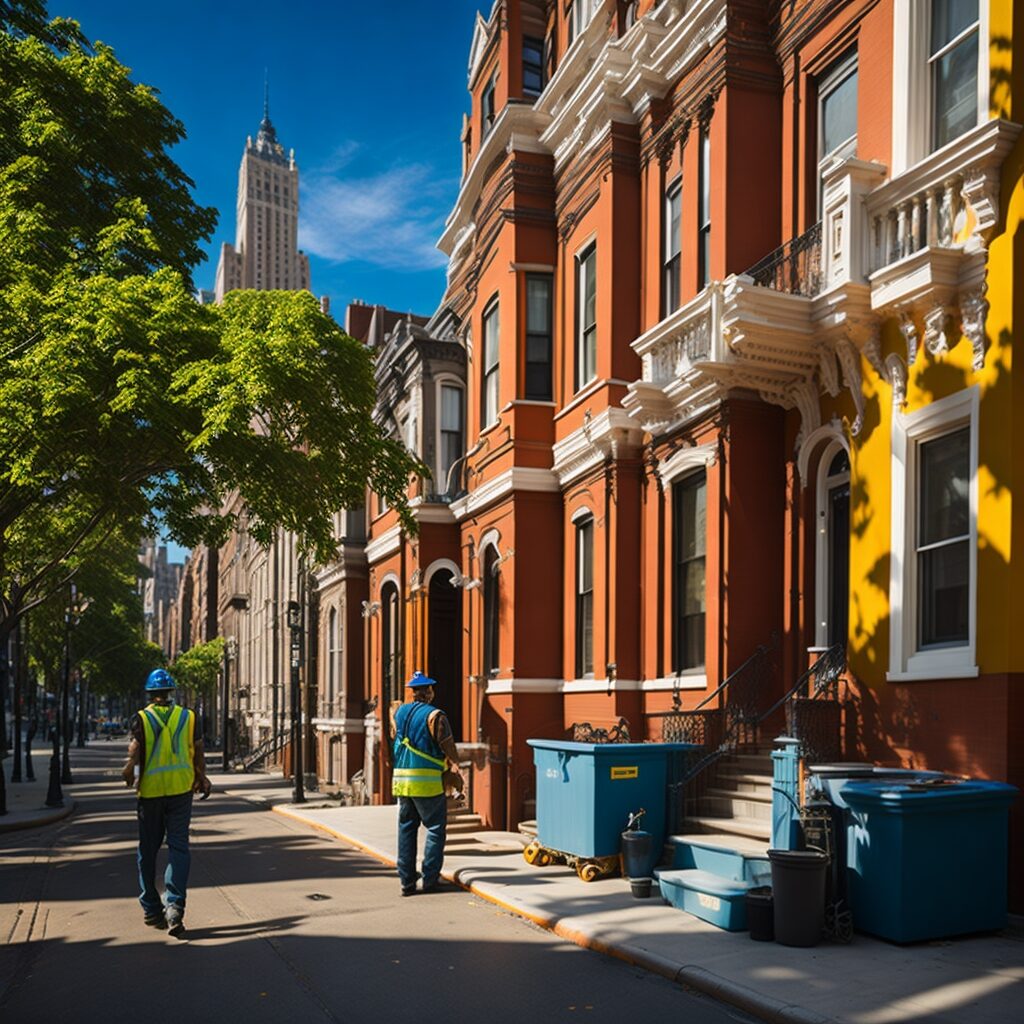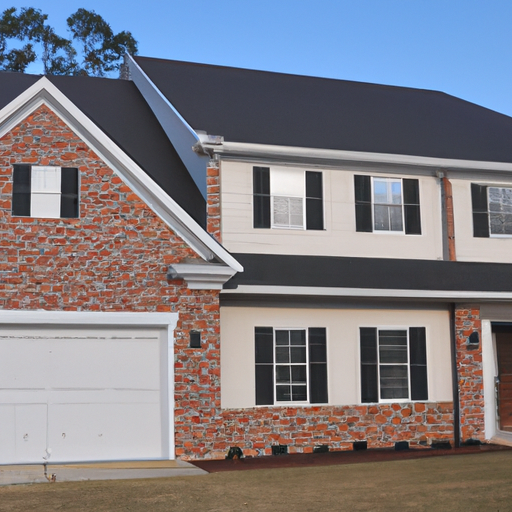Chicago Residential Home Painting Tips – Steps Involved
Have you ever wondered what it takes to paint the exterior of a residential home? 🏠 Well, you’re in luck! Today, we’re going to discuss the steps involved in painting a residential exterior home.
Whether you’re planning on doing it yourself or hiring a professional, understanding the process can help you make informed decisions and achieve the desired look for your home. So, let’s dive in and explore the fascinating world of residential exterior painting!
First and foremost, preparation is key. Before you even pick up a paintbrush, you’ll need to thoroughly clean the exterior surfaces to remove dirt, grime, and any loose paint. This can be done using a pressure washer or a combination of detergent and water. Next, you’ll need to inspect the surfaces for any signs of damage or rot. If you come across any issues, it’s important to address them before moving forward to ensure a smooth and long-lasting paint job.
After the surfaces are clean and in good condition, it’s time to prime them. Applying a primer is essential for creating a solid base for the paint and enhancing its adhesion.
Be sure to choose a primer that is suitable for the type of surface you’re working with, whether it’s wood, stucco, or brick. Once the primer has dried, you can start applying the paint. This can be done using brushes, rollers, or sprayers, depending on the size of the area and your personal preferences.
Finally, it’s important to take proper care of your newly painted exterior. Regular maintenance, such as cleaning and touch-ups, can help extend the life of the paint job and keep your home looking fresh and vibrant.

In our upcoming article, we’ll delve deeper into each of these steps and provide you with tips and tricks to help you achieve professional-looking results. Stay tuned, and get ready to transform your home’s exterior with a fresh coat of paint! 🎨
- Preparation 🧹✨
- Cleaning the Surface 🧽🚿
- Scraping and Sanding ✂️🔨
- Repairing Damages 🛠️🔧
- Priming 🖌️🎨
- Choosing the Right Primer 🎯👌
- Applying the Primer 🖌️👷♂️
- Painting 🎨🏠
- Choosing the Paint 🎨🔍
- Selecting the Appropriate Tools 🛠️🧰
- Applying the Paint 🖌️👷♂️
- Finishing Touches ✨🦋
- Adding Finishing Coats 🛡️🎉
- Trimming and Detailing 🎀✂️
- Cleaning Up 🧹🧽
- Inspection 👀🔍
- Checking the Paint Job ✅🔍
- Touching Up Any Imperfections 🖌️✏️
- Protection 🛡️🏠
- Protecting the Painted Surface 🛡️🚧
- Maintenance 🧹🧼
- Regular Cleaning 🧽🚿
- Periodic Repainting 🎨📆
Now that we have a brief overview of the steps involved in painting a residential exterior home, let’s explore each step in detail.
Preparation
Before you start painting, it’s essential to prepare the exterior surface of your home. This step ensures that the paint adheres properly and provides a long-lasting finish.
Cleaning the Surface
Start by thoroughly cleaning the exterior surface using a mild detergent or a power washer. Remove any dirt, mildew, or loose paint. A clean surface allows the paint to bond effectively and prevents peeling and cracking.
Scraping and Sanding
Next, inspect the surface for any loose or peeling paint. Use a scraper to remove the old paint, taking care not to damage the underlying surface. After scraping, sand the area to create a smooth and even surface for the new paint.
Repairing Damages
Inspect the exterior for any damages, such as cracks or holes. Use a suitable filler or patching compound to repair these areas. Allow the repairs to dry thoroughly and sand them if necessary. This step ensures a seamless and flawless paint job.
Priming
Before applying the paint, it’s crucial to prime the surface. Primer creates a protective barrier and helps the paint adhere better, resulting in a more durable and even finish.
Choosing the Right Primer
Select a primer that suits the type of surface you are painting. For example, if you are painting over a bare wood surface, choose a wood primer. Make sure the primer is compatible with the paint you plan to use.
Applying the Primer
Apply the primer evenly using a brush or a roller. Start from the top and work your way down, ensuring full coverage. Allow the primer to dry as per the manufacturer’s instructions before moving on to the next step.
Painting
Now it’s time to add a fresh coat of paint to your residential exterior. Choose a high-quality paint that is specifically formulated for exteriors, as it will withstand weather conditions and provide long-lasting protection.
🎨 Read our article about how to Select the Right Paint Colors
Choosing the Paint
Consider factors such as the climate and the type of surface when selecting the paint color and finish. Opt for paints with UV protection and a weather-resistant formula to ensure the color remains vibrant and the surface is well-protected.
Selecting the Appropriate Tools
Use a high-quality brush or roller that suits the type of paint and surface. Brushes are ideal for detailed areas, while rollers are efficient for large, flat surfaces. Additionally, use painter’s tape to protect windows, doors, and other areas you don’t want to paint.
Applying the Paint
Start painting from the top and work your way down, using long, steady strokes. Apply multiple thin coats rather than a single thick coat for a smoother and more professional finish. Allow each coat to dry fully before applying the next one.
Finishing Touches
After the main painting is complete, it’s time to add the finishing touches to give your residential exterior a polished look.
Adding Finishing Coats
Consider adding a clear finish or topcoat to enhance the durability and appearance of the paint. Clear finishes provide additional protection against the elements and make the color pop.
Trimming and Detailing
Take care of any trim work or detailing, such as painting windows, doors, and shutters. Pay attention to the small details to achieve a cohesive and visually pleasing finish.
Cleaning Up
After you have completed the painting, clean your tools and dispose of any leftover paint or debris responsibly. Proper cleanup ensures that your painting materials are ready for future use and keeps your surroundings tidy.

Inspection
Once the paint has dried completely, carefully inspect the painted surface to ensure a top-quality finish.
Checking the Paint Job
Look for any missed spots, streaks, or imperfections in the paint. Make any necessary touch-ups using the same paint color and a small brush. Taking the time to review the paint job ensures that your residential exterior looks flawless.
Touching Up Any Imperfections
If you notice any minor imperfections such as rough areas or paint drips, gently sand them and apply a touch-up coat of paint. These small touch-ups will make a significant difference in the overall appearance of your home.
Protection
To maintain the beauty and longevity of your newly painted exterior, take steps to protect the surface from potential damage.
Protecting the Painted Surface
Consider applying a clear protective layer or sealant over the paint to shield it from UV rays, moisture, and other environmental factors. This extra layer of protection will help prevent fading, peeling, and other forms of damage over time.
Maintenance
Regular maintenance is key to preserving the beauty and integrity of your residential exterior.
Regular Cleaning
Periodically clean the painted surface using a mild detergent and a soft sponge or brush. This removes dirt, dust, and other pollutants that can dull the paint’s appearance. Rinse thoroughly with clean water and allow the surface to air dry.
Periodic Repainting
Over time, the paint on your residential exterior may fade or become damaged. Schedule periodic repainting to keep your home looking fresh and well-maintained. Regular repainting not only enhances the curb appeal but also helps maintain the value of your property.
Conclusion
Painting a residential exterior home involves several steps, from thorough preparation to adding finishing touches. By following these steps and using high-quality materials and tools, you can create a beautiful and long-lasting paint job. Remember to protect and maintain the painted surface to enjoy the benefits of your hard work for years to come. Happy painting!
Check our local Chicago partner sites out including Chicagolands best dentist at Six Corners Family Dental. Need a Chicago criminal defense attorney, contact Adams Defense Law. Visit Chicago Web Services for any Google Search Engine Marketing or WordPress work.
Visit the Cerebral Surge on YouTube for the best educational videos. Check out the AI Chat Guy for the latest on Artificial Intelligence News
TOP CHICAGO PAINT CONTRACTOR
Let the best Chicago interior painters in the city help you with your next painting project. Contact us today for a free estimate on your exterior painting or interior painting job in Chicago or the north suburbs.
5444 N La Crosse Ave
Chicago, Il 60630
Phone: (773) 777-0048
Fax: (773) 777-0048
Cell: (773) 419-1718
Email: sam@acleanlook.com
🍀 Chicago Interior Painting Services
🍀 Chicago Exterior Painting Services


